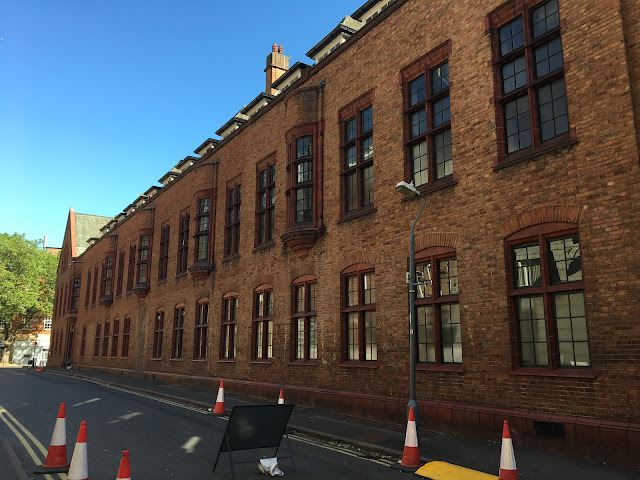To Birmingham last week and a family wedding; and what a moving, joy filled day it was. Beautiful weather and much happiness. A day spent on foot for we walked from the Registrar's to the reception in bosky, rus in urbe, Edgebaston. And back.
We did indeed do a lot of walking that weekend, and saw a lot of the city. The return to our hotel Friday evening along Broad St was particularly egregious - "The Road, like all main roads into a big city, achieved a kind of vast squalid importance .... it was a life line with a low opinion of life."*
Early the next morning we traversed the city centre to the north end of Corporation St to get the bus to Lichfield. Corporation St., it must be remembered, was Joseph Chamberlain's well meant but slightly cack-handed attempt at a 'Parisian Boulevard'. Judging from old photographs, even when new it seemed to lack the visual cohesiveness necessary, and that cohesiveness is even less apparent today. One wonders if it could ever, at a certain level, really succeed - after all laisez-faire Birmingham was not the Second Empire.
The northern section of the street is the legal centre of the city, what with the mediocre Crown Court and the spectacularly blood-red terracotta Victoria Law Courts by Aston Webb and Ingress Bell**. There are Barrister's chambers everywhere. But oh how that part of the city looked neglected. The old County Court building, 1882, by John Williamson, in a fine Neo-Renaissance style and which I mistook it for a Victorian Bank (A confusion of typologies?), is empty and forsaken; the towers and pinnacles of Law Courts sprout shrubbery.*** It is not at all acceptable that a functioning public building should be such a condition. However the presence of the paraphernalia of building works does suggest (hopefully) that restoration is at hand.
The whole thing however piqued my interest in what appeared to be an down-at-heal part of the city centre, and when I got back here I had a trawl on the internet. It revealed the whole sorry tale of the destruction of a vast area of the city in the 1950&60s. Of an urban landscape sacked and left for dead. A whole area of the city dis-enchanted. The damage done to Whittall St was particularly telling and deeply saddening. Frustrating. Enraging. It all seems a long way from the 'Civic Gospel' of late nineteenth century city.
Sometimes I feel, as much as I actually like Birmingham, that it isn't really a city at all just a conglomeration of random buildings. A simulacrum.
**Sir Aston Webb, you may recall from an earlier post, was architect of Birmingham University.
*** Turns out the County Court building is still a functioning law court. Well, there you go.



No comments:
Post a Comment